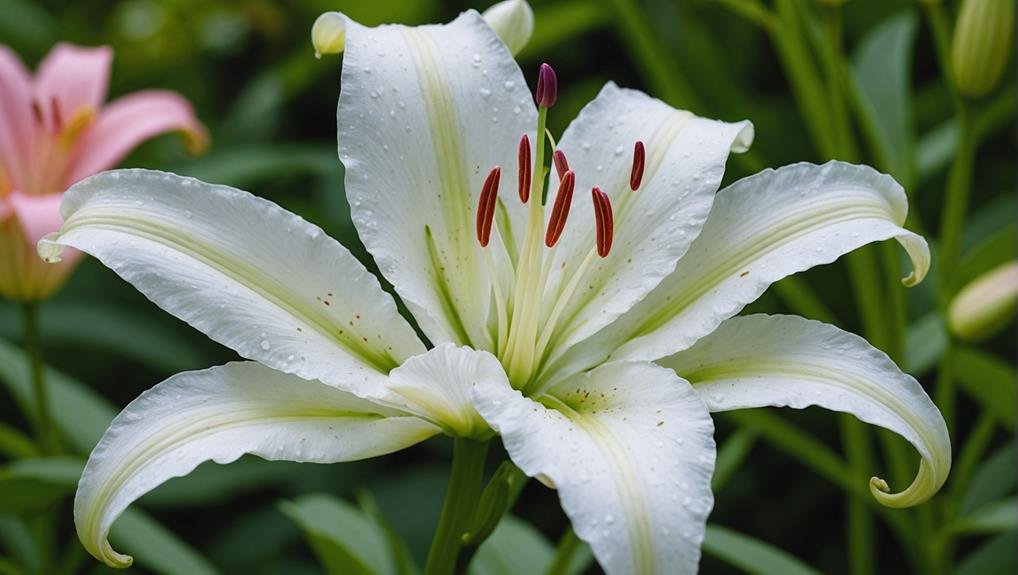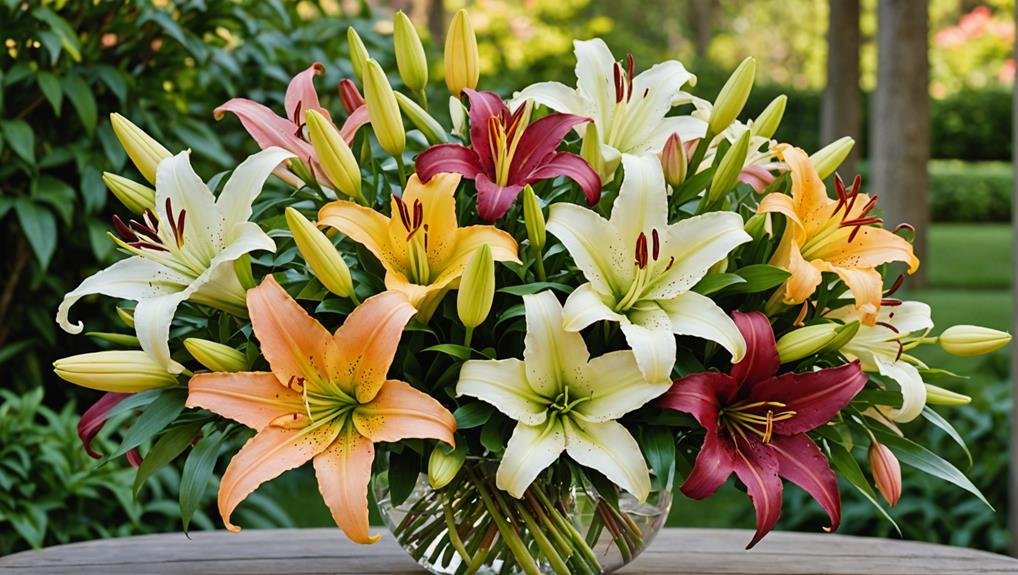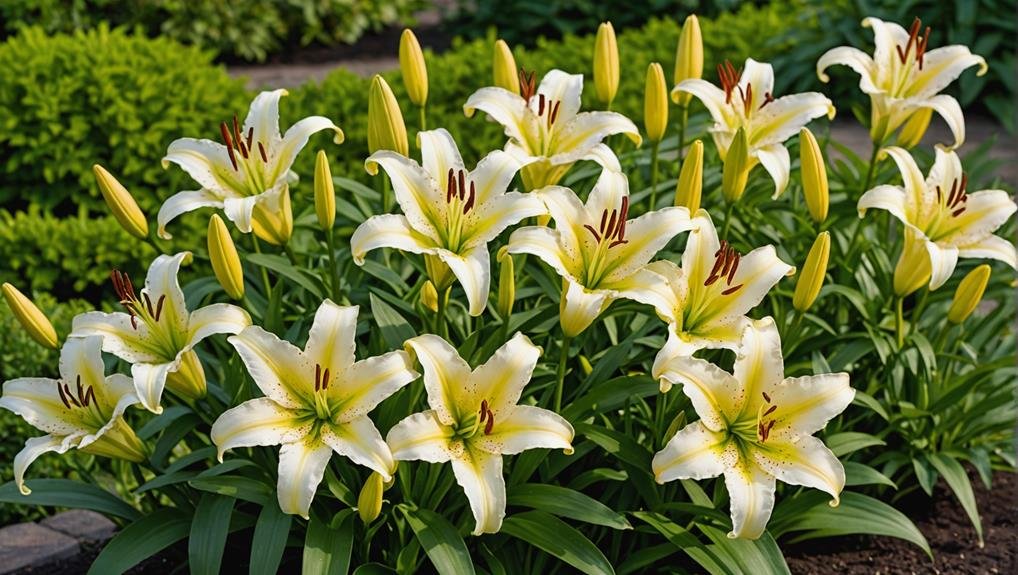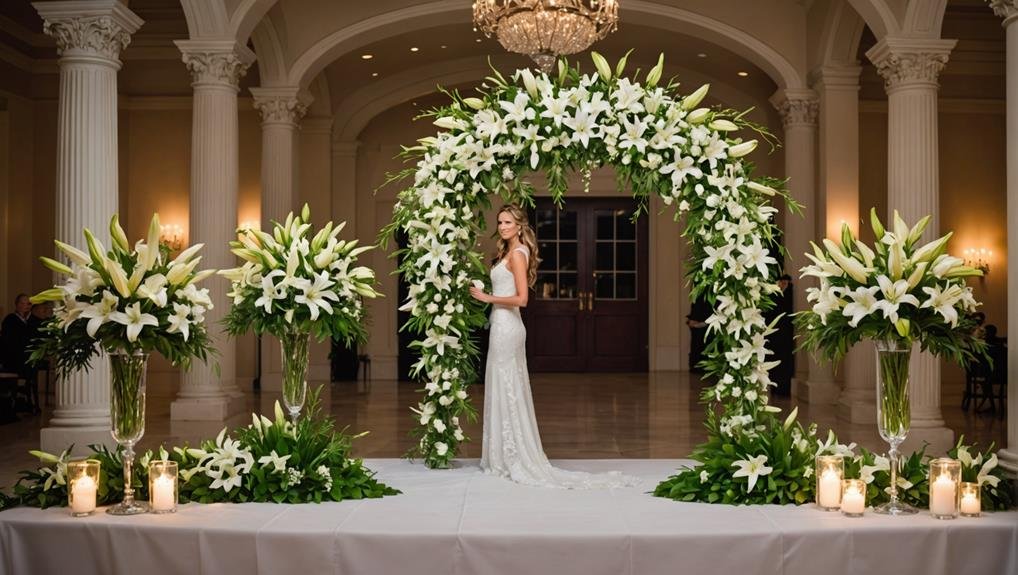Lily flowers, admired for their timeless elegance and versatility, play a pivotal role in many wedding celebrations, offering both aesthetic appeal and symbolic depth. Their trumpet-shaped blooms come in a diverse palette, from pure white to striking pinks and oranges, catering to various themes and color schemes. Known for their enchanting fragrance and long, graceful stems, lilies are often featured in bridal bouquets, centerpieces, and overall decor. To fully appreciate the significance and practical applications of lilies in weddings, one must consider their botanical characteristics, cultural symbolism, and the myriad ways they can enhance the ambiance of your special day.
Flower Overview

Lilies, with their elegant trumpet-shaped blooms, are among the most popular choices for wedding flowers. Their timeless beauty and versatility make them a favorite for brides and florists alike. Lilies come in a variety of types, including Asiatic, Easter, Calla, Oriental, and Lily of the Valley, each offering unique characteristics that can complement a range of wedding themes and color palettes.
A significant advantage of choosing lilies for wedding bouquets is their long in-season period, which spans from spring to fall. This allows for greater flexibility in wedding planning, as different varieties bloom at specific times throughout these seasons. The cost per stem of lilies generally ranges from $4 to $8, although prices can fluctuate based on factors such as color and seasonal availability.
In wedding bouquets, lilies can be incorporated in various ways. They can be mixed with other flowers to create a lush, textured arrangement or used alone for a sleek, sophisticated look. The trumpet-shaped blooms of lilies add a dramatic flair to any bouquet, making them a stunning choice for brides seeking elegance and simplicity in their floral arrangements.
Physical Description
Renowned for their striking trumpet-shaped blossoms, these flowers exhibit a range of colors including white, pink, red, and orange. Lilies are celebrated for their large blooms, which can instantly elevate the elegance of any wedding arrangement. Each bloom consists of six broad, overlapping petals that curve outward, creating a visually appealing, symmetrical trumpet shape. The petals often feature intricate details such as speckles or freckles, adding a layer of uniqueness to each flower.
Lilies are also notable for their strong, sweet fragrance, which can permeate the air and create an inviting atmosphere. This fragrance is particularly prominent in varieties such as the Stargazer lily. The flowers typically grow on long stems that can reach up to six feet tall, making them ideal for dramatic floral displays. These stems often support multiple blooms, contributing to the flower’s lush and abundant appearance.
The leaves of lilies are another distinctive feature. They are generally long, narrow, and dark green, providing a rich, verdant backdrop that enhances the vibrancy of the blooms. This combination of large, colorful petals and sleek, green leaves makes lilies a popular choice for wedding decor.
Available Colour Varieties

With their wide range of colors, lily flowers offer a stunning array of hues spanning from classic white to lively shades of pink, red, orange, and yellow. This versatility makes lilies a popular choice for different wedding themes and color schemes.
For brides looking for a traditional look, white calla lilies provide a timeless grace. In contrast, those aiming for a strong impact can choose deep purple or Dark Purple Calla lilies, which bring a touch of refinement and intensity to any floral arrangement.
Orange lilies, including the vivid orange calla lilies, bring a cheerful and lively atmosphere, ideal for summer or autumn weddings. The pink tones of Stargazer lilies, often embellished with speckles, offer a romantic and whimsical feel, while Asiatic lilies showcase a range of bright colors like orange and yellow.
Purple calla lilies, with their unique and remarkable coloring, can serve as a captivating focal point or complement a diverse range of floral colors.
The wide color selection of lilies allows for endless creative possibilities when crafting wedding bouquets, corsages, boutonnieres, and other floral arrangements. This flexibility guarantees that lily flowers can seamlessly blend into any wedding vision, from soft pastels to rich jewel tones.
Latin Name and Taxonomy
The Latin term for the lily is Lilium, and these graceful flowers belong to the diverse Liliaceae family. As herbaceous blooming plants, lilies are renowned for their exquisite trumpet-shaped blooms and sweet fragrance, making them a favorite in wedding floral arrangements.
The genus Lilium encompasses over 100 species, showcasing an impressive range of shapes, sizes, and colors. This diversity is further expanded by the cultivation of hybrid lilies, which are created by crossing different species to produce unique and enchanting varieties.
Taxonomically, lilies are categorized within the Liliaceae family, a classification that underscores their shared characteristics and botanical lineage. The Lilium genus is home to various notable groups, including Asiatic lilies, known for their vibrant colors and hardiness, and Oriental lilies, celebrated for their large, fragrant blooms.
Hybrid lilies, such as the popular Stargazer lily, exemplify the ingenuity of horticulturists in developing new and exciting varieties that combine the best traits of their parent species.
Understanding the Latin term and taxonomy of lilies provides a deeper appreciation for their botanical significance and the extensive variety they offer. This knowledge is invaluable for selecting the perfect lilies to enhance any wedding celebration.
Geographical Origins

Originating from the temperate regions of the Northern Hemisphere, lilies have a rich geographical history that spans Europe, Asia, and North America. These elegant flowers are not only admired for their beauty but also for their diverse habitats, which contribute significantly to their cultivation and propagation.
The majority of lilies are cultivated in China, Japan, and the Netherlands, with these regions playing pivotal roles in the global flower market. Each area offers unique conditions that allow various species of lilies to thrive. China and Japan, in particular, have long-standing traditions of lily cultivation, contributing to the rich genetic diversity and availability of these flowers.
Lilies are also found growing wild in other regions, showcasing their adaptability to different environments. Some key geographical origins include:
- Himalayas: Home to several wild lily species that flourish in alpine meadows.
- Mongolia: A region where lilies have adapted to harsher climates.
- Parts of Africa: Although less common, some species have made their home here.
- Europe: Various species thrive in the well-drained soils and moderate climates.
- North America: Known for its diverse lily varieties, from coastal areas to inland regions.
These geographical origins underscore the lily’s versatility and global appeal.
Season Availability
Throughout the year, lilies captivate with their seasonal blooms, offering a variety of options for weddings and special events. Understanding the season availability of different lily varieties can help in planning the perfect Lily Wedding Bouquets.
| Lily Variety | Bloom Time | Ideal Use in Weddings |
|---|---|---|
| Easter Lilies | Late March-April | Spring weddings, symbolizes purity |
| Asiatic Lilies | May-June | Early summer weddings, vibrant colors |
| Calla Lilies | Early Summer | Elegant bouquets, versatile arrangements |
| Oriental Lilies | July-August | Mid-summer weddings, fragrant and bold |
| Stargazer Lilies | July-August | Dramatic bouquets, striking appearance |
Easter lilies typically bloom in late March or April, making them perfect for spring weddings. Asiatic lilies, known for their vibrant colors, are in season during May and June, ideal for early summer ceremonies. Calla lilies, with their sleek and elegant form, bloom in early summer and are a sophisticated choice for a range of wedding arrangements.
In mid-summer, Oriental lilies, including the popular Stargazer lilies, are in full bloom, offering a fragrant and visually striking option for Lily Wedding Bouquets. With thoughtful consideration of season availability, brides can ensure their floral arrangements are both beautiful and timely.
Growing Conditions

Understanding the most suitable growing conditions for lilies can significantly enhance their beauty and longevity, ensuring they remain a stunning addition to any wedding bouquet. Lilies thrive in well-drained soil, which helps prevent waterlogging and root rot. Full sun exposure is vital for their development, as it promotes robust growth and vibrant blooms. Additionally, lilies prefer slightly acidic soil, with a pH level between 6.0 and 6.5, which supports nutrient absorption and overall plant health.
Regular watering is essential, especially during dry periods, to maintain soil moisture without causing saturation. For best growth, bulbs planting should be done in the fall or spring. This timing allows the lilies to establish their root systems before the growing season begins.
Key points to remember when cultivating lilies include:
- Well-drained soil: Essential to prevent waterlogging and root rot.
- Full sun exposure: Promotes robust growth and vibrant blooms.
- Slightly acidic soil: Ideal pH level between 6.0 and 6.5.
- Regular watering: Maintains soil moisture, crucial during dry periods.
- Best growth: Plant bulbs 6-8 inches deep and 6-12 inches apart in fall or spring.
Cultural Significance
Celebrated for their exquisite beauty and symbolic richness, lilies hold significant cultural importance across various societies and traditions. The word ‘lily’ itself is derived from the Greek word ‘leiron,’ traditionally referring to true lilies known for their elegance and purity.
In many cultures, the traditional white lily is emblematic of virtue and innocence. This association is particularly strong in Greek mythology, where lilies are linked to the goddesses Hera and Artemis, symbolizing purity and motherhood.
In China, lilies are revered as symbols of good fortune and motherhood, often given as gifts to convey wishes of prosperity and happiness. The cultural significance of lilies extends to religious ceremonies as well. For instance, Easter lilies are widely used in Christian traditions to represent purity and renewal during the Easter season.
Different hues of lilies carry distinct meanings in various cultures. In Japan, white lilies signify purity and rebirth, while the combination of Red and White or Pink and White lilies can symbolize unity and everlasting love.
This rich tapestry of meanings highlights why lilies are cherished across the globe, embodying a range of sentiments from devotion to renewal and beyond.
Typical Use in Weddings

Given their rich cultural significance and multifaceted symbolism, lilies are a favored choice for various elements in wedding ceremonies. Their elegant appearance and sweet scent make them one of the most popular wedding flowers. Lilies symbolize purity, devotion, love, and happiness, aligning perfectly with the themes of a wedding day. Whether used as white flowers or in other hues, they add a touch of sophistication and beauty to wedding floral designs.
Incorporating lilies into wedding arrangements can be achieved in numerous ways:
- Lily Bouquet: A classic choice for the bride, a lily bouquet can serve as the centerpiece of a bridal bouquet, exuding elegance and grace.
- Corsages and Boutonnieres: Lilies can be used to create delicate and stylish corsages and boutonnieres, perfect for the bridal party and close family members.
- Centerpieces: Lilies are ideal for table centerpieces, adding a refined and fresh look to the reception decor.
- Aisle Decorations: Line the wedding aisle with lilies to create a breathtaking pathway for the bride and groom.
- Ceremony Backdrop: Use lilies in large floral arrangements to frame the altar or ceremony space, providing a stunning backdrop for vows.
Alternative Flower Types
When considering alternative flower types for wedding arrangements, several options offer unique beauty and symbolism. Asiatic lilies, known for their extensive color palette, are ideal for couples seeking bold colors without the traditional lily scent. Their versatility makes them a fitting choice for both classic and modern weddings.
Easter lilies, with their pristine white and pink hues, are particularly popular for spring ceremonies, adding a touch of freshness and purity to the occasion.
Calla lilies, often featured in elegant calla lily weddings, symbolize beauty and come in various shades, including white and pink. Their sleek, sophisticated appearance makes them a timeless choice for classic wedding themes.
For those desiring a fragrant option, Oriental lilies such as Stargazer lilies offer a sweet scent and come in vibrant colors like white, pink, and red, adding both olfactory and visual appeal.
Lily of the valley is another excellent alternative, representing love and happiness. Its delicate, bell-shaped flowers are perfect for DIY weddings, allowing for creative and personal floral arrangements.
Whether opting for bold colors or a more subtle palette, these alternative flower types ensure a memorable and beautiful wedding day.
